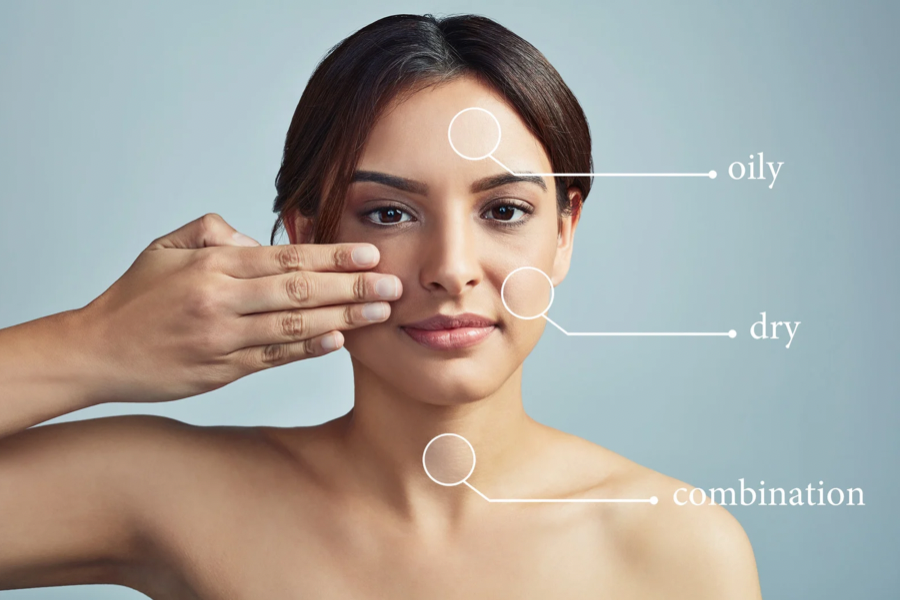Introduction
In this blog post. we delve into the world of skincare by exploring the five fundamental skin types. If you’re someone eager to elevate your skincare routine, understanding your unique skin type is the crucial first step. Please keep in mind that these descriptions are meant to serve as a guide and individual skin can vary.
The Five Basic Skin Types:
1. Normal Skin

Normal skin is well-balanced and neither too oily nor too dry. It has a smooth texture, small pores, and a healthy complexion. If you have normal skin, congratulations! You’re one of the lucky ones. It’s estimated that 20-30% of the population falls into this category. Here are some personalized skincare tips (as if you need any, bitches):
Use a gentle cleanser twice a day to maintain the skin’s natural balance.
Moisturize daily to keep the skin hydrated and supple.
Exfoliate regularly to remove dead skin cells and promote a radiant complexion.
Protect your skin from the sun by using a broad-spectrum sunscreen.
Consider incorporating anti-aging products into your skincare routine to maintain youthful-looking skin.
2. Oily Skin

Oily skin is characterized by an overproduction of sebum, the skin’s natural oil. People with oily skin often have shiny skin, enlarged pores, and are prone to acne and breakouts. If you have oily skin, here are some personalized skincare tips:
Use a gentle cleanser twice a day to remove excess oil and impurities.
Avoid heavy moisturizers and opt for oil-free or gel-based moisturizers instead.
Exfoliate regularly to unclog pores and prevent breakouts.
Use a mattifying primer before applying makeup to control shine.
Avoid touching your face throughout the day to minimize transferring excess oil.
3. Dry Skin

Dry skin lacks moisture and often feels tight and rough. It may appear dull and flaky and is more prone to fine lines and wrinkles. If you have dry skin, here are some personalized skincare tips:
Use a gentle, hydrating cleanser that does not strip away the skin’s natural oils.
Moisturize daily with a rich, nourishing moisturizer to replenish moisture and improve skin elasticity.
Avoid hot showers and baths, as hot water can further dry out the skin.
Exfoliate gently to remove dead skin cells and promote cell turnover.
Protect your skin from harsh weather conditions by using a moisturizing sunscreen.
4. Combination Skin

Combination skin is characterized by having both oily and dry areas on the face. Typically, the T-zone (forehead, nose, and chin) is oily, while the cheeks and other areas may be dry or normal. If you have combination skin, here are some personalized skincare tips:
Use a gentle cleanser twice a day to remove excess oil and impurities.
Apply a lightweight, oil-free moisturizer to the dry areas of your face.
Use a mattifying primer on the oily areas to control shine.
Exfoliate regularly to unclog pores and remove dead skin cells.
Consider using different products for different areas of your face to address specific concerns.
5. Sensitive Skin

Sensitive skin is easily irritated and prone to redness, itching, and inflammation. It may react to certain skincare products, environmental factors, or even stress. If you have sensitive skin, here are some personalized skincare tips:
Use a mild, fragrance-free cleanser that is specifically formulated for sensitive skin.
Avoid harsh exfoliants and opt for gentle exfoliation methods, such as using a soft washcloth or a mild chemical exfoliant.
Choose skincare products that are hypoallergenic and free of potential irritants.
Always patch test new products before applying them to your entire face.
Protect your skin from the sun by using a sunscreen with a high SPF and physical blockers like zinc oxide or titanium dioxide.
Can Someone Have More Than One of These Skin Types?

Yes, skin types can be quite diverse, and individuals may exhibit characteristics of more than one type. For example, someone with dry skin may also have sensitive skin. Skin types can also change over time due to factors such as age hormonal change, and environment. Remember, skincare is not one-size-fits-all, so it’s important to adjust your skincare routine based on the specific needs of your skin.
Determining Your Skin Type

If you are still unsure about your skin type, there are a few simple tests you can do to help determine it:
Blotting Paper Test: Gently press blotting paper on different areas of your face. If the paper picks up oil from all areas, you likely have oily skin. If it only picks up oil from the T-zone, you may have combination skin. If there is little to no oil on the paper, you may have dry or normal skin.
Bare Face Test: Wash your face with a gentle cleanser and refrain from applying any skincare products. After an hour, observe your skin. If it feels tight, dry, or flaky, you likely have dry skin. If it looks shiny and feels greasy, you likely have oily skin. If it feels comfortable and balanced, you likely have normal or combination skin.
Reaction Test: Pay attention to how your skin reacts to different products or environmental factors. If your skin becomes red, itchy, or irritated easily, you likely have sensitive skin.
What Factors Contribute to the Development of Different Skin Types?

Our skin type is primarily determined by a combination of genetic and environmental factors. There are a few key factors that contribute to different skin types.
- Genetics: The genes we inherit from our parents play a role in determining our skin type. Certain genes influence the production of proteins, such as collagen and elastin, which affect our skin’s elasticity, texture, and overall appearance.
- Sebum Production: Sebaceous glands produce a natural oil called sebum. The amount of sebum produced varies among individuals, which affects skin type. Those with larger sebaceous glands tend to have oilier skin, while those with smaller glands may have drier skin.
- Melanin Production: Melanin in the pigment that gives color to our skin. The amount of distribution of melanin determines our skin color and also contribute to different skin types. People with higher levels of melanin tend to have darker skin, while lower levels result in lighter skin. Melanin also provides some level of natural protection against the sun’s UV rays.
- Environmental Factors: External factors such as climate, humidity, pollution, and UV exposure can influence and affect our skin type. For instance, excessive sun exposure can lead to more prominent signs of aging, including wrinkles and sunspots, while dry and cold climates can cause dehydration or dryness.
It’s important to note that our skin type can change over time, as I mentioned before. This can be due to factors such as hormonal changes, aging, lifestyle, and skincare habits. It’s always advisable to take care of your skin by adopting a suitable skincare routine and protecting it from harmful environmental factors.
Conclusion

In conclusion, understanding your unique skin type is crucial for taking care of your skin, your largest organ. By understanding your skin type and providing it with the appropriate care, you can maintain a healthy and radiant complexion. As I said earlier, skincare is not a one-size-fits-all approach, so it’s important to listen to your skin’s needs and adjust your routine accordingly. Consult with a dermatologist if you have any concerns or specific skincare issues.

